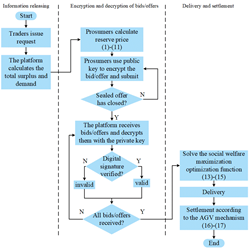Global Energy Interconnection
Global Energy Interconnection
The provision of low carbon energy to our society is a key issue at the heart of sustainable development of global energy supply. The Global Energy Interconnection (GEI) Journal publishes original res...
The provision of low carbon energy to our society is a key issue at the heart of sustainable development of global energy supply. The Global Energy Interconnection (GEI) Journal publishes original research on theories and developments as well practical applications on principles of large scale low carbon energy generation, transmission, distribution & storage technologies, global energy interconnection & system developments, global energy policy and energy market operations, global climate changes & environmental impacts, global energy transition strategies and global energy governance. GEI journal has been indexed in multiple databases such as EI Compendex, Scopus, Inspec, DOAJ, Elsevier ScienceDirect, etc.
The potential for renewable energy to make contributions to mitigating the impact of climate change is expected to increase significantly in the longer term. Renewable energy generation technologies including onshore wind, offshore wind, wave, tidal, marine current, and ocean thermal energy generation as well as PV power generation, which are considered essential to meet long term aim of reducing CO2 emissions, have experienced rapid development and significant progresses during the past 10 years.
Decarbonizing the power & energy sector by ramping up the adoption of renewable energy is essential to meet the goals of the Paris Agreement where the required acceleration of the global shift to low carbon can only be achieved through a combination of clean energy generation, modern transmission technologies, power grid interconnectivity, energy storage as well energy policy, which all play important roles in the transition.
The scope of Global Energy Interconnection includes the following but not necessarily restricted to:
I.Operation and Planning of Global Energy Interconnection
- Theoretical analysis and economic incentives to facilitate the implementation of Global Energy Interconnection
- Conceptual and system development strategies, realization paths and comprehensive values of Global Energy Interconnection
- System planning, design techniques and tools and economic analysis of Global Energy Interconnection
II. Global Energy Transformation, Climate Change and Global Energy Governance
- Strategies for Carbon Emissions Reduction and Global Experiences
- Impacts of Renewable Energy Developments on Climate Changes and Economic Evaluation
- Global Energy Governance and Energy Cooperation to address Climate Change
- Low Carbon Technology of Power Grid
III. Smart Grids
- Wide area/ultra wide area monitoring, estimation, protection and control (WAMPAC)
- basic WAMPAC building blocks including PMUs, communication infrastructure, Data Concentrator solutions, management and processing of big data, knowledge extraction from big data, cyber security
- Innovative operation and control of power grids using Wide area/ultra wide area information
- Adaptive identification and corrective techniques/technologies for power grids using Wide area/ultra wide area information
- System Integrity Protection Schemes (SIPS) - Special Protection Schemes; Remedial Action Schemes
- Design of modern Energy Management Systems (EMS) and Distribution Management Systems (DMS), their applications to support energy connectivity and global energy interconnection
- Techniques /Technologies for real-time dynamic security assessment, situational awareness, prevention of power system blackouts and approaches for power system restoration
- New concepts of robust, secure, reliable, self-healing and resilient power systems
- Technologies and new solutions for ancillary services to support smart grids and global energy interconnection
IV. Advanced Power Transmission Technologies/Techniques
- Advanced transmission technologies including High-Voltage/Ultra High Voltage AC transmission, High-Voltage/Ultra High Voltage DC transmission, flexible AC/DC transmission systems
- Wide area/Ultra wide area co-optimized planning of generation and transmission resources
- Real world experiences of AC/DC transmission expansion applications tailored to higher penetration levels of fluctuating/remittent renewable energies
- Innovative control and protection principles as well as practical control and protection experiences for interconnected power grids and global energy interconnection
V. Low Carbon and Clean Energy Technologies and System Integration
- Renewable Energy Technologies (e.g., wind, solar, hydro, biomass, etc), clean fossil fuel technologies (e.g., carbon capture), marine energy (wave, tidal, seawater desalination, etc) and their integration into modern energy systems
- Energy storage technologies: Design, construction, operation, control and system planning as well as market operations and innovative business models
- Interactions and integration between electricity and other energy vectors and sectors (including heating, cooling, gas, hydrogen, transport and energy storage)
- Technologies to enhance flexibility in future energy systems and energy interconnection as well as global energy interconnection
- Operation, control and protection pf low carbon clean energy generation systems
Society affiliation
Global Energy Interconnection Development and Cooperation Organization (GEIDCO) is an international organization among willing firms, associations, institutions dedicated to advancing the sustainable development of energy worldwide. The mission of GEIDCO is to promote the establishment of Global Energy Interconnection (GEI) to meet the global powe...





